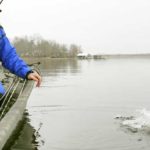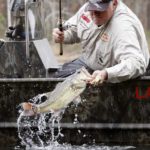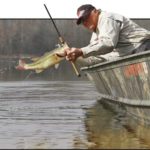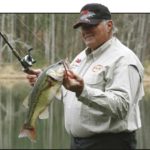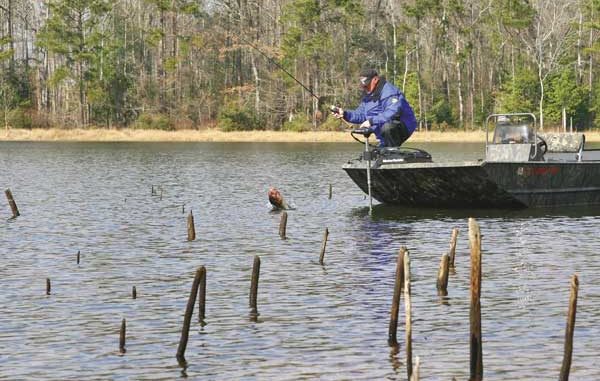
Across Louisiana, bass have moved their beds to deeper water to escape detection from anglers.
Like a commercial I saw on an outdoor channel recently, Caney Lake bass used to put up their little white flags when they saw me coming. It wasn’t so much that they knew I was going to catch all of them as it was their realizing I was about to pester the heck out of them for the next several hours. It used to be that when I got word the bass had moved up to spawn I would call in sick to work, skip church and do just about anything else it took to get to the lake as often as I could. I was hooked on sight fishing for all those big bass that were bedding in shallow water, and I wasn’t the only one.
Back in those days, legions of anglers would form lines around the perimeter of Caney Lake, and terrorize the spawning bass. As soon as one angler caught a fish, the line would rotate, and the next boat would antagonize that same fish until it bit again.
Several sore lips and a few years later, the beds that used to be so obvious in the stickups and vegetation around the bank started becoming harder and harder to find. We could still find a bass or two, but it got to the point where it was one or two per cove rather than per every 100 feet.
Take into consideration that these were Florida-strain largemouth bass, which some have called the moodiest and most temperamental of any fish in the lake, and it didn’t take an ichthyologist to see what was going on. The pressured bass spawning in shallow water were getting hip to the deal.
“The bass here in Caney used to start spawning in the coves on the north banks from 2 to 4 foot when the water was somewhere between 60 and 65 degrees,” said Caney Lake guide Eddie Halbrook, who actually hunted the lake bottom before impoundment.
“People used to come out here in what I called deer-stand boats,” he continued. “They had these big ladder stands set up on their decks so they could see deeper into the water. Everybody could see that the bass were starting to spawn in deep water, and they were trying to stay ahead of the game.”
Right after the grass died out around 2000, Halbrook started noticing an even greater tendency for the bass to spawn in progressively deeper water. Bass that were spawning in 2 to 4 feet moved out to 6 to 8 feet. From there, it became 8 to 10 feet, where many still spawn today.
Many anglers eventually gave up because they were still looking for bass beds by running the coves, but the fish just weren’t there in great numbers anymore. Rather than adapt to the changes taking place under their own noses, they loaded their boats and left for greener pastures.
“Eight to 10 feet seems to be pretty typical today,” said Halbrook. “But I have caught spawning bass as deep as 20 feet. You can find a lot of deeper bass in these depths off the bank lines, but the really best spots are the tops of the humps out in the main lake that top off at about 8 to 12 feet.”
It is on these deeper spots that Halbrook believes bass can find everything they found in shallow water except for one thing — intense angling pressure. And because these deep-spawning bass aren’t pestered as much, they are much more likely to bite for anglers willing to put in the time to find them.
Bass can’t just magically move deeper and start spawning, though. They still have to find certain things to have a successful spawn. A firm bottom that is not buried under too much muck is important, as bass will fan away the muck to get to the hard substrate.
Nearby cover in the form of wood or vegetation is also important to help protect the beds. And, according to BASS Elite Series Pro Jeff Connella from Bentley, they need sunlight to make their eggs viable.
“I’ve seen fish spawn on a stump in 15 feet of water,” said Connella, “but the top of that stump was only about 2 feet under the surface. As I understand it, bass will only spawn as deep as the sun will penetrate the water … to incubate their eggs so they will hatch. We’ve seen bass spawning deeper and deeper on tour, but they don’t go so deep that it kills the eggs. They may spawn beyond the sun penetration, but they won’t be successful if they do.”
At Caney Lake, spawning in water up to 20 feet deep isn’t much of a concern for the bass since the lake is so clear. Sunlight can get down that deep, and the bass that spawn at those depths are successfully able to hatch their eggs. Even though anglers can’t see the beds, they can rest assured there isn’t much different about a deep bed and a shallow bed.
“Everybody who knows me knows that I keep my Aqua-Vu camera with me in my boat all the time,” Halbrook said. “I’ve put that camera down to where I thought bass were spawning, and I could see exactly what they were doing.”
The main thing that Halbrook has seen is that the deep beds are still swept out clear spots like they are in shallow water. In the deeper spots, he has noticed they like to get around a stump or log, and particularly at the bases of the standing willows that remain at the bottom of the lake.
“I’ve even seen these fish spawning on the sides of these willows like they would on a cypress tree,” he said. “And I know these were all actively spawning fish because I would watch them go through their little courting ritual with my camera.”
Without the aid of an underwater camera, Halbrook suggested that anglers could find some deep-spawning bass by watching their electronics carefully during spawning season. Any hump that rises up to about 8 to 12 feet should be marked with a buoy and investigated closer with a few casts.
Halbrook and Connella agree that anglers shouldn’t expect immediate success when first setting up on a deep spawning spot because, along with moving deeper, bass are starting to show other tendencies that have stemmed from increased pressure.
“I’ve noticed that bass are starting to get really bad, or good depending on how you look at it, about spooking way off a bed — even one in 5 or 6 feet of water — when an angler first pulls up,” said Connella. “They will leave and make a huge circle before they come back to the bed. If you don’t sit there and stare at an empty bed for 10, 15 or even 20 minutes or more, you’ll leave before that fish comes back.”
Connella based this information on the fact that sight fishermen are learning how to effectively spot deeper spawning fish. While they are not as clear as the shallow beds, bass can be seen on some of the deeper beds. It’s definitely not a high-definition image, and it comes down to spotting movement or shadows.
“At Caney, the bass may move off the top of the hump as soon as you pull up and not come back for 30 minutes or more,” Halbrook added. “I’ve fished the top of a hump where I knew there were spawning bass and not caught one for up to an hour after I first set up. They’ll definitely wait until things settle down before they move back on the beds.”
If it sounds like bass are getting smarter and smarter every year, that’s because they are. Anglers have become so educated that a bass on a bed is as good as caught today, and this is forcing the fish to do some different things. This is especially true in areas where catch and release is more prevalent than catch and keep.
And if it weren’t for people like Halbrook and Connella who have figured out how to catch these deeper fish, these smart bass would be totally undisturbed. Luckily for us, our education process continues.
These two anglers have opposite approaches on how they fish deep spawning bass, but both are successful at what they do. While their favored techniques may vary somewhat, any of them could work for you as long as you try them on your lake this spring.
“I really only throw three things on these deep fish,” said Halbrook. “I throw a big jig, a big spinnerbait and a big lizard on a Carolina rig. The key to these three is that they’re all big because I’m hunting the bigger fish.”
It’s not uncommon for Halbrook to throw all three lures in one spot to see if one triggers the bite better than the others. However, weather plays a big role in which one he thinks will work best.
On windy days, Halbrook begins with either 3/8- or 1/2-ounce chartreuse/white Cyclone Big Easy spinnerbaits. He lets the big blade go all the way to the bottom, where he begins working it much like he would a jig by lifting and dropping it through the bedding areas.
“I get more bites on it if it’s really windy,” he said. “Ten- to 20-m.p.h. winds here at Caney can present a factor to be reckoned with. Sometimes if the wind is too bad, I’ll just let it sink and pull it slowly and steadily while maintaining constant bottom contact.”
Halbrook employs the jig and Carolina rig more so on calmer days and when the sun is out and bright. Being that he’s looking for a big bite, he rigs his Cyclone jig with a large crawfish trailer, which he drags across the bottom with slight hops every now and then.
The Carolina rig is perhaps the simplest choice for fishing the deep beds at Caney because it allows an angler to cover so much water with a fast-moving presentation that is also a finesse presentation. Add the big 9-inch lizard to it, and you have perhaps the perfect bait for fishing big, deep-spawning bass.
“That’s the best way for anybody to come out here and catch the deeper fish no matter what their skill level,” Halbrook said. “It’s not that hard to fish, and you can often feel the bite better on it than you can the jig or spinnerbait. Just go to a heavier weight in windy conditions, and stick with about a 3-foot leader. And my favorite lizard for Caney is the watermelon/red 9-inch V&M Big Hawg Lizard.”
While Halbrook moves to the big side for deep spawning bass, Connella does just the opposite. He has had success by downsizing to small split-shot rigs and small white and pink plastics if he can see the bed but not the fish because of the depth.
“To me, there’s a difference between trying to make a shallow bed fish bite by basically beating him up with a lot of casts and a lot of different lures,” said Connella. “With the deeper fish, I’m trying to make them eat rather than bite out of frustration. That’s why I go with the finesse stuff.”
Connella added that anglers set out to fish deep spawning fish shouldn’t forget about the sunglasses they wear. Just like a more expensive camera lens or riflescope offers better optics and lens coatings, so can the more expensive pairs of shades.
“Quality shades like the Smith Optics that I wear will help you see fish better because they have real glass lenses that don’t distort what you see,” he said. “Wearing good shades could make that shadowy figure on a deep bed all of a sudden look more like a bass than a log.”
Even with all the special tactics and gear that Halbrook and Connella use to catch the deeper bass, Halbrook pointed out that catching these fish might be just as easy as fishing out the other side of the boat.
“Anybody who just has to fish the shoreline will catch more fish during the spawn today if they either throw in front of their boat parallel to the bank or turn and cast out to the deeper water,” he said. “Sometimes it’s just as simple as fishing where the fish are rather than trying to force them to be somewhere they’re not.”
With the increased fishing pressure from smarter anglers the past several years, it’s no wonder bass are starting to spawn in deeper water. Humans don’t want anybody watching what they do in their beds, and neither do bass.
However, if you continue your education process and stay one step ahead of the fish, you should continue to have successful spring trips during the spawn. You may not see very many white surrender flags, but you will see that you can catch bass if you start thinking a little deeper.

